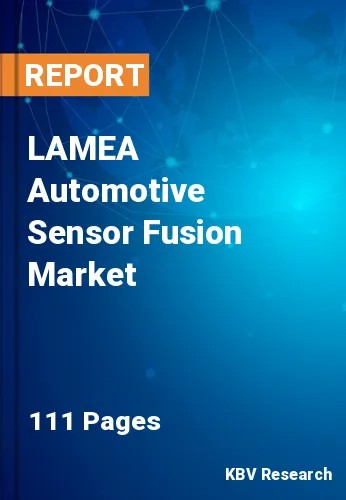Chapter 1. Market Scope & Methodology
1.1 Market Definition
1.2 Objectives
1.3 Market Scope
1.4 Segmentation
1.4.1 LAMEA Automotive Sensor Fusion Market, by Propulsion Type
1.4.2 LAMEA Automotive Sensor Fusion Market, by Vehicle Type
1.4.3 LAMEA Automotive Sensor Fusion Market, by Technology
1.4.4 LAMEA Automotive Sensor Fusion Market, by Country
1.5 Methodology for the research
Chapter 2. Market Overview
2.1 Introduction
2.1.1 Overview
2.1.1.1 Market Composition & Scenario
2.2 Key Factors Impacting the Market
2.2.1 Market Drivers
2.2.2 Market Restraints
Chapter 3. Competition Analysis - Global
3.1 KBV Cardinal Matrix
3.2 Recent Industry Wide Strategic Developments
3.2.1 Partnerships, Collaborations and Agreements
3.2.2 Product Launches and Product Expansions
3.2.3 Acquisition and Mergers
3.3 Top Winning Strategies
3.3.1 Key Leading Strategies: Percentage Distribution (2018-2022)
3.3.2 Key Strategic Move: (Product Launches and Product Expansions : 2019, Oct – 2022, Nov) Leading Players
Chapter 4. LAMEA Automotive Sensor Fusion Market by Propulsion Type
4.1 LAMEA ICE Market by Country
4.2 LAMEA BEV Market by Country
4.3 LAMEA HEV Market by Country
Chapter 5. LAMEA Automotive Sensor Fusion Market by Vehicle Type
5.1 LAMEA Passenger Cars Market by Country
5.2 LAMEA Light Commercial Vehicles Market by Country
5.3 LAMEA Heavy Commercial Vehicles Market by Country
Chapter 6. LAMEA Automotive Sensor Fusion Market by Technology
6.1 LAMEA IMU Market by Country
6.2 LAMEA Image Sensors Market by Country
6.3 LAMEA Radar Sensors Market by Country
6.4 LAMEA Others Market by Country
Chapter 7. LAMEA Automotive Sensor Fusion Market by Country
7.1 Brazil Automotive Sensor Fusion Market
7.1.1 Brazil Automotive Sensor Fusion Market by Propulsion Type
7.1.2 Brazil Automotive Sensor Fusion Market by Vehicle Type
7.1.3 Brazil Automotive Sensor Fusion Market by Technology
7.2 Argentina Automotive Sensor Fusion Market
7.2.1 Argentina Automotive Sensor Fusion Market by Propulsion Type
7.2.2 Argentina Automotive Sensor Fusion Market by Vehicle Type
7.2.3 Argentina Automotive Sensor Fusion Market by Technology
7.3 UAE Automotive Sensor Fusion Market
7.3.1 UAE Automotive Sensor Fusion Market by Propulsion Type
7.3.2 UAE Automotive Sensor Fusion Market by Vehicle Type
7.3.3 UAE Automotive Sensor Fusion Market by Technology
7.4 Saudi Arabia Automotive Sensor Fusion Market
7.4.1 Saudi Arabia Automotive Sensor Fusion Market by Propulsion Type
7.4.2 Saudi Arabia Automotive Sensor Fusion Market by Vehicle Type
7.4.3 Saudi Arabia Automotive Sensor Fusion Market by Technology
7.5 South Africa Automotive Sensor Fusion Market
7.5.1 South Africa Automotive Sensor Fusion Market by Propulsion Type
7.5.2 South Africa Automotive Sensor Fusion Market by Vehicle Type
7.5.3 South Africa Automotive Sensor Fusion Market by Technology
7.6 Nigeria Automotive Sensor Fusion Market
7.6.1 Nigeria Automotive Sensor Fusion Market by Propulsion Type
7.6.2 Nigeria Automotive Sensor Fusion Market by Vehicle Type
7.6.3 Nigeria Automotive Sensor Fusion Market by Technology
7.7 Rest of LAMEA Automotive Sensor Fusion Market
7.7.1 Rest of LAMEA Automotive Sensor Fusion Market by Propulsion Type
7.7.2 Rest of LAMEA Automotive Sensor Fusion Market by Vehicle Type
7.7.3 Rest of LAMEA Automotive Sensor Fusion Market by Technology
Chapter 8. Company Profiles
8.1 NVIDIA Corporation
8.1.1 Company Overview
8.1.2 Financial Analysis
8.1.3 Segmental and Regional Analysis
8.1.4 Research & Development Expense
8.1.5 Recent strategies and developments:
8.1.5.1 Product Launches and Product Expansions:
8.1.6 SWOT Analysis
8.2 NXP Semiconductors N.V.
8.2.1 Company Overview
8.2.2 Financial Analysis
8.2.3 Regional Analysis
8.2.4 Research & Development Expense
8.2.5 Recent strategies and developments:
8.2.5.1 Partnerships, Collaborations, and Agreements:
8.2.5.2 Product Launches and Product Expansions:
8.2.6 SWOT Analysis
8.3 Robert Bosch GmbH
8.3.1 Company Overview
8.3.2 Financial Analysis
8.3.3 Segmental and Regional Analysis
8.3.4 Research & Development Expense
8.3.5 Recent strategies and developments:
8.3.5.1 Partnerships, Collaborations, and Agreements:
8.3.5.2 Acquisition and Mergers:
8.3.6 SWOT Analysis
8.4 TE Connectivity Ltd.
8.4.1 Company Overview
8.4.2 Financial Analysis
8.4.3 Segmental and Regional Analysis
8.4.4 Research & Development Expense
8.4.5 SWOT Analysis
8.5 Infineon Technologies AG
8.5.1 Company Overview
8.5.2 Financial Analysis
8.5.3 Segmental and Regional Analysis
8.5.4 Research & Development Expense
8.5.5 Recent strategies and developments:
8.5.5.1 Partnerships, Collaborations, and Agreements:
8.5.5.2 Product Launches and Product Expansions:
8.6 ZF Friedrichshafen AG
8.6.1 Company Overview
8.6.2 Financial Analysis
8.6.3 Regional Analysis
8.6.4 Research & Development Expenses
8.6.5 Recent strategies and developments:
8.6.5.1 Partnerships, Collaborations, and Agreements:
8.6.5.2 Product Launches and Product Expansions:
8.7 TDK Corporation
8.7.1 Company Overview
8.7.2 Financial Analysis
8.7.3 Regional & Segmental Analysis
8.7.4 Research & Development Expenses
8.7.5 Recent strategies and developments:
8.7.5.1 Product Launches and Product Expansions:
8.8 STMicroelectronics N.V.
8.8.1 Company Overview
8.8.2 Financial Analysis
8.8.3 Segmental and Regional Analysis
8.8.4 Research & Development Expense
8.8.5 Recent strategies and developments:
8.8.5.1 Partnerships, Collaborations, and Agreements:
8.8.5.2 Product Launches and Product Expansions:
8.9 Aptiv PLC
8.9.1 Company Overview
8.9.2 Financial Analysis
8.9.3 Segmental and Regional Analysis
8.9.4 Research & Development Expense
8.9.5 Recent strategies and developments:
8.9.5.1 Product Launches and Product Expansions:
8.9.5.2 Acquisition and Mergers:
8.10. Texas Instruments, Inc.
8.10.1 Company Overview
8.10.2 Financial Analysis
8.10.3 Segmental and Regional Analysis
8.10.4 Research & Development Expense

